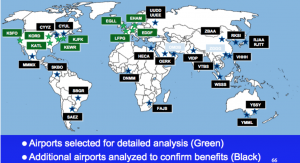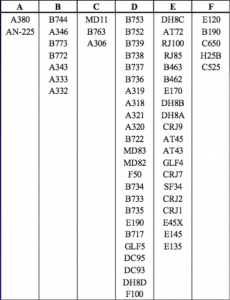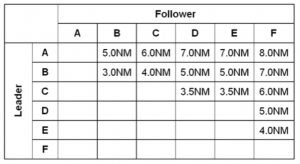52ND ANNUAL CONFERENCE, Bali, Indonesia, 24-28 April 2013WP No. 90Study Recategorization of Aircraft for Wake TurbulencePresented by TOC |
Summary
Current wake turbulence categories have been considered outdated and unnecessarily restrictive. To address this inefficiency, FAA and EUROCONTROL have launched the RECAT initiative. In its initial phase, RECAT aims to establish up to six wake turbulence categories; eventually evolving into a dynamic pair-wise separation system.
This paper proposes Policy concerning these efforts.
Introduction
1.1 Wake turbulence separation minima have been established between aircraft categories based on weight.
1.2 As wake turbulence separation is an important constraint to capacity, efforts are being made to develop more rational categorization. The main effort, launched by EUROCONTROL and the FAA, is RECAT.
1.3 TOC was tasked to study such efforts in order to identify the possible effects of a change in existing Wake Turbulence Categories.
Discussion
2.1 Definition and effects of wake vortex turbulence
2.1.1 Wake Vortex Turbulence is defined as turbulence that is generated by the passage of an aircraft in flight. It will be generated from the point when the nose landing gear of an aircraft leaves the ground on take off, and will cease to be generated when the nose landing gear touches the ground during landing.
2.1.2 Potentially hazardous turbulence in the wake of an aircraft in flight is principally caused by wing tip vortices originated as a consequence of the generation of lift by a wing. The strength of the vortex is governed by the weight, speed, and shape of the wing of the generating aircraft. Vortices usually persist between one and three minutes. The effect of the vortex on the encountering aircraft depends on the strength of the vortex and the weight, speed and aerodynamics of the affected aircraft.
2.1.3 An aircraft penetrating a vortex from another aircraft on a similar trajectory and axis can experience an un-commanded roll. This situation is mostly encountered close to the ground in the vicinity of airports where aircraft are on approach to or departing from particular runways. The low altitude makes these encounters especially dangerous.
2.1.4 Wake vortex encounters are not exclusive of aircraft approaching to the same runway. Moderate crosswind conditions could increase the probability of such incidents in parallel runway operations.
2.2 Categorization of aircraft
2.2.1 As weight is the main factor contributing to the generation of wake turbulence and also a crucial factor in the severity of the effects of such turbulence, aircraft have been categorized according to their maximum certificated takeoff mass. In Doc 4444 PANS ATM, ICAO defines three categories with a fourth one (Super Heavy) defined by a State letter:
- L (Light) aircraft types of 7,000 kg (15,500 lb) or less
- M (Medium) aircraft types less than 136,000 kg (300,000 lb) and more than 7,000 kg (15,500 lb)
- H (Heavy) aircraft types of 136,000 kg (300,000 lb) or more
- Super Heavy for Airbus A380-800 with a maximum take-off mass in the order of 560.000 kg
2.2.2 Some countries use categories different to the ones defined by ICAO. In the USA for example the FAA defines 5 categories while the UK has a 6 categories system and Switzerland has divided the Medium category in two sub-categories.
2.2.3 Separation minima are defined according to the categories for two aircraft in the same sequence. Minima can be based in distances for radar control or based in time. As an example this is the minimum separation required by ICAO. The blank cells are cases where minimum radar separation applies:

Countries that use categories other than those defined by ICAO apply their own separation rules. One example is the FAA table of separation minima:

2.3 Limitations of the current categorizations
2.3.1 Runway capacity is limited by the minimum separation between aircraft, among other factors. Delays and runway efficiency could be improved if the separation required for wake turbulence, could be safely reduced. As a consequence, the current model has been studied to find potential improvements.
2.3.2 The current categorization is based solely on weight, without taking other factors into account. These factors include the aerodynamics of the involved aircraft, airspeeds and meteorological conditions. Although weight is an important parameter it is not the only one making the allocation of aircraft to weight categories an issue.
2.3.3 According to the current categories, the same separation minima would apply for a plane having a mass of 90,000 Kg following another one with a mass of 20,000 Kg than for a plane of 20,000 Kg following a 90,000 Kg one. As stated by ICAO in AN- Conf/12-WP/41 there may be an over-protection thus a potential loss of runway capacity.
2.3.4 The FAA and EUROCONTROL jointly launched the RECAT initiative in 2005 to study ways to improve the current system.
2.4 RECAT 1
2.4.1 RECAT has three phases, the first one focusing on optimization of the ICAO wake turbulence separation classes, with up to six categories.
2.4.2 ICAO is aware that an incremental increase in the number of categories would lead to an increase in the workload of Air Traffic Controllers. In the correspondent document for the 12th Air Navigation Conference ICAO states that:
“more classes lead to more complexity for the air traffic controller, creating the need for support tools”.
Nonetheless it was agreed for this first phase of RECAT that as six classes are already used today at some aerodromes this number of classes may be considered manageable without providing controller management tools. This was considered by the RECAT team as the best compromise for short term implementation.
2.4.3 No Big-Bang implementation is intended. New categories can coexist with former ones depending on the ANSP or the airport involved.
2.4.4 The study was done for 61 aircraft types that represent the 80% of the traffic in the USA and Europe according to samples at five US and four European airports. Additional airports were analyzed worldwide.

Slide from a presentation on RECAT
2.4.5 The problem was how to group these 61 aircraft in six categories in the most optimal way, without increasing the current exposure to wake turbulence. Wake strength and rolling moment coefficient were used as hazard metrics being data collected by LIDAR and anemometers.
2.4.6 Mathematically there are 5,461,512 possible groupings. The solution adopted was submitted to experts to be reviewed. The final result can be seen in the following table:

2.4.7 The separation proposed for these new categories is shown in the following table with blank cells meaning minimum radar separation applied:

2.4.8 The system already has been implemented in KMEM (Memphis) with promising results leading to the FAA’s interest in the program’s expansion to other airports. Following the initial trials at KMEM, the FAA estimates a 15% capacity gain for the particular fleet mix involved at the airport.
2.4.9 This six category system is not optimized for every airport and the efficiency may be reduced as the fleet mix changes over time. Nonetheless, the FAA expects an average of a 7% capacity increase.
2.5 RECAT 2
2.5.1 The second step in RECAT is currently under definition. It is a medium-term project supported by SESAR and NEXTGEN.
2.5.2 The project aims to replace the separation classes with a system pairing aircraft. Each aircraft pair would have its own wake turbulence separation minima.
2.5.3 Currently there are some 1,200 types of aircraft in the world being the vast majority light planes. RECAT 2 would build a table pairing them, which is a 1,200 x 1,200 table with 1,440,000 possibilities.
2.5.4 States would decide how to implement the pair-wise separation minima. This could be done by grouping the aircraft in a limited number of categories.
2.5.5 As an example, the vast majority of operations in EGLL are performed by 25 aircraft types. If a given airport has a 99% of operations made by 25 aircraft a 25×25 matrix of 625 cells would cover 99% of operations. Smaller separation matrices would be possible without much sacrifice to efficiency (a 10×10 matrix with 2-3 aircraft per category or a 6×6 matrix with 4-5 aircraft per category). The RECAT 1 categories would cover all other pairs.
2.5.6 While the RECAT team considered that automation would not be necessary in Phase 1, it is acknowledged that some kind of automation would be essential to assist the controller in the handling of such a vast amount of data.
2.6 RECAT 3
2.6.1 While RECAT 2 is designed to use a static “pair-wise” regime, RECAT 3 is intended to use a dynamic “pair-wise” system where actual conditions such as aircraft mass or meteorological conditions are considered to establish wake turbulence separation minima.
2.6.2 RECAT 3 could take advantage of the lessons learned from other projects aiming to modify the separation according to the wind conditions. CREDOS (Crosswind- Reduced Separation for Departure Operations), for example, is a project under the 6th Framework Program of the European Commission which aims to take advantage of crosswinds that sweep away the turbulence in order to reduce the time needed to clear an aircraft for take off after a heavier aircraft has departed.
2.6.3 Other European projects that use dynamic separation are TBS (Time-Bases Spacing) coordinated by EUROCONTROL and NATS that uses Time Based separation instead of Distance Based during strong headwinds conditions while CROPS (Crosswind Operations) aims to a reduction in 0.5 NM of wake turbulence distance separation on final approach under specific headwind or crosswind conditions.
2.6.4 There are also projects intended to provide dynamic separation in the USA that could be used in the future RECAT 3. WTMD (Wake Turbulence Mitigation for Departures) is an acronym to refer collectively to projects aiming to improve departure operations depending on the wind conditions while WTMA (Wake Turbulence Mitigation for Arrivals) is intended to apply similar procedures for arrivals under certain wind situations.
2.7 Issues
2.7.1 The following policy concerning Mixed Mode Operations (MMO; ATS 3.14) is considered relevant to the studied subject:
|
Mixed mode operations are defined as ATM Operations that require different procedures due to variances in airspace users’ characteristics and/or ATM design within the same area of controller responsibility. Efforts should be undertaken to reduce existing Mixed Mode Operations by creating intrinsically safe solutions. Introductions of new Mixed Mode Operations should be avoided by creating intrinsically safe solutions. When safety of a Mixed Mode Operation cannot be completely managed at an intrinsic level, assessment must take place that the change in the ATM system does not increase controller workload to an unacceptable level. |
2.7.2 RECAT brings up several issues. RECAT advocates for an implementation where old and new categories can coexist as seen in 2.4.3. IFATCA Policy on Mixed Mode Operations as quoted in 2.7.1 states that this should be avoided by creating intrinsically safe solutions. If such solutions cannot be found, then assessment must take place to ensure that the change does not increase controller workload to an unacceptable level.
2.7.3 A second issue is the introduction of new categories and the potential impact on controller workload and ultimately safety. As quoted in 2.4.2 ICAO states in AN- Conf/12-WP/41
“as six classes are already in use today at some aerodromes this would be the best compromise for short term implementation without need for additional support tools”.
The assumption that the six classes in use today can easily be replaced by six different classes does not seem to be supported by a proper safety assessment. The potential negative impact on complexity and on controller workload must be managed.
2.7.4 The RECAT project was launched for capacity gains, but an increase of capacity is probably linked to an increase in the controller’s workload while the adding of new categories increases complexity. A comparison between the tables provided under 2.2.3 and 2.4.7 seems to confirm this assumption in that the number of separation pairs to handle increases from 7 (ICAO table) to 15 (RECAT 1 table). On the other hand the live trials in Memphis give a 15% capacity gain as seen in 2.4.8 implying increased workload. The RECAT team acknowledges that some kind of automation may be needed but delays the whole issue for Phase 2 with no further details nor any tool described. IFATCA believes that a potential increase in controller workload beyond acceptable levels must be managed by the creation of intrinsic safe solutions. This could be done through Controller Tools or other automation, but all other potential solutions must be considered as well. The ultimate goal of the automated support is to avoid an unacceptable increase in controller workload.
Conclusions
3.1 Current wake turbulence categorizations are based on weight as being the main factor contributing to the generation of wake turbulence. However, there are more contributing factors than weight alone.
3.2 Runway capacity is, among other factors, limited by wake turbulence separation. It has been thought that a more rational categorization of aircraft could improve capacity with hardly any effect on safety.
3.3 In 2005 EUROCONTROL and the FAA launched the RECAT initiative to study ways to improve the current categories system.
3.4 RECAT has three phases: the first one aims to improve upon the ICAO wake turbulence classes, replacing them with a new model including up to six categories. The second one is a mid-term effort to replace separation classes with a system pairing types of aircraft, resulting in minimum separation for each pair.The third phase would add dynamic factors like wind conditions or actual aircraft mass.
3.5 No Big-Bang implementation is intended for any of the RECAT phases. Each airport could use any of the systems according to its needs.
3.6 RECAT1 has been tested in Memphis with a 15% increase in capacity.
3.7 IFATCA has Policy on MMO; this Policy demands intrinsic safe solutions in order to avoid new MMO. If the safety of an MMO cannot be managed at the intrinsic level, IFATCA Policy demands the assessment of controller workload, to ensure that it is not increased above acceptable levels.
3.8 The assumption has been made by the RECAT team that the increase in the number of wake turbulence categories for Phase 1 can be safely done without the need of any support tools. Some form of automation would be needed for the phases 2 and 3. This reveals some haste to implement RECAT in order to have a quick gain in capacity. It is crucial that controller workload and task complexity are properly managed to avoid an increase above acceptable levels. Controller Tools or other automation support might be the solution, but other options need to be considered as well.
3.9 There are some other projects aiming at the implementation of dynamic wake turbulence separation depending on the existence of specific meteorological conditions.
Recommendations
It is recommended that;
4.1 IFATCA Policy is:
IFATCA recognizes the efforts to change current wake turbulence categories and the corresponding separation standards. Certain concepts have the potential to lead to an increase in complexity for the controller and therefore also an increase in controller workload. These concepts can only be supported provided that this increase in controller workload does not exceed acceptable levels.
and is included in the IFATCA Technical and Professional Manual.
References
ICAO: AN-Conf/12-WP/41, Redefinition of ICAO Categories for Wake Turbulence (RECAT).
Steven Lang (FAA) and Catalin Lepadatu (EUROCONTROL); Wake Vortex Worshop: Recategorization of the Wake Turbulence Separation Minima, RECAT.
EUROCONTROL; Wakenet-3 Europe Workshop: Recategorization of the Wake Turbulence Separation Minima, RECAT.
Paul Wilson (EUROCONTROL): Wake Vortex.
FAA & EUROCONTROL: Presentation on Wake Turbulence Re-Categorization Phase I.
Methodology and Safety Case.
FAA & EUROCONTROL: Leader/Follower Static Pairwise (RECAT Phase II).
FAA & EUROCONTROL: Dynamic Pairwise (RECAT Phase III).
FAA Safety Alert for Operator SAFO 12007 Date 18th October 2012.
Frank M. Robasky, David A. Clark (MIT Lincoln Laboratory): A Wind Forecast Algorithm to Support Wake Turbulence Mitigation for Departures (WTMD).
Daniel Williams, Gary Lohr (NASA Langley Research Center): Wake Turbulence Mitigation for Arrivals (WTMA).
Dr. Debbie Mitchell (NATS); Wakenet-3 Europe: Overview of active Wake Vortex Concepts in Europe.
David Booth (EUROCONTROL): Time Based Separation – Transitional Step (TBS- TS) & Crosswind Operations (CROPS).


